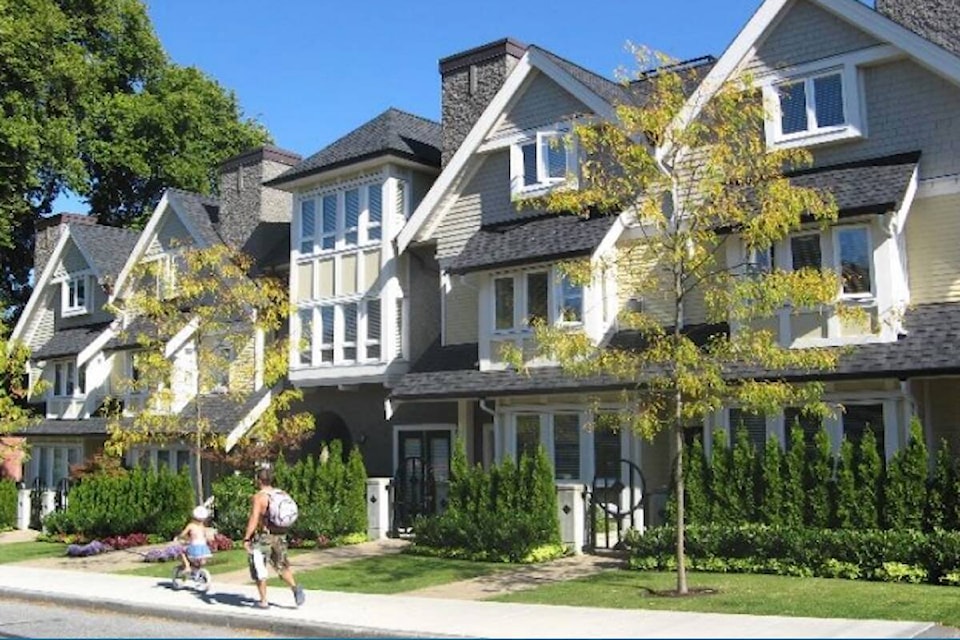After receiving little uptake, Victoria has voted to tweak its policy that aims to build more multi-family buildings on lots that for half a century only allowed single-family dwellings.
Councillors approved several updates to the missing middle initiative on Thursday (Sept. 28) as they sought to undo what city staff called too prescriptive and onerous regulations.
Those restrictive building conditions saw only three acceptable applications coming forward under the initiative in its first six months.
The missing middle policy streamlines the approval process for houseplexes, corner townhomes and some infill homes. It aims to boost the diversity and overall supply of homes, especially one that can support families, while also supporting the city’s sustainable transportation, greenspace and urban forest goals.
The amount of missing middle types getting built has not kept up with demand in recent years, staff said. Victoria permitted 110 missing middle homes over the last two years, but needed to approve more than 300 to keep up with the city’s housing needs.
Coun. Jeremy Caradonna said when the proposal was being considered, critics said it would see neighbourhoods bulldozed while proponents hoped it would alleviate housing struggles. In reality, neither panned out as the current regulations saw almost nothing approved, he said.
Council approved several amendments from Caradonna that went slightly further than updates proposed by staff. Among them was keeping vehicle requirements for missing middle buildings, but delegating parking variance approvals to staff. Caradonna said the tweak allows developers to pitch car-free projects, while other councillors agreed builders know who they want to market to and could instead replace driveways with greenspace.
Census data shows 18,245 City of Victoria residents commuted by car, van or truck in 2021 – down from 19,075 in 2016 despite the city’s population growing by 8 per cent (6,000 residents) over that time.
Councillors approved amending the allowable heights of houseplexes and corner townhomes to 11 metres for flat-roofed buildings and 12 metres for sloped ones. Staff had proposed just rising houseplex heights by 1.5 metres to ensure they could be built with adaptable units on lots with a wider range of topography and so those more accessible spaces would be close to the ground floor.
The higher heights pushed by Caradonna aim to give builders the flexibility to still have three above-grade storeys along with a livable basement unit. He also won the support of colleagues to reduce front yard setbacks for houseplexes from six to four metres, in hopes it would create larger backyards.
Other changes councillors supported to hopefully increase the viability of projects include: allowing townhouses on half of corner lots instead of 40 per cent; making secondary suites within a building optional instead of requiring at least one; removing overlap with coming provincial building code updates and more.
Coun. Stephen Hammond voted against the updates –along with Coun. Marg Gardiner – and asked if missing middle will deliver “affordable” units (30 per cent of a household’s income). He cited a Ratehub report showing as of August, the average Victoria household needed an income of $185,000 to afford an average home ($880,000).
Staff said the initiative can address affordability if it’s teamed with the rest of Victoria’s 40-point housing plan. Asking missing middle to solely tackle the high prices would lead to less housing getting built – likely worsening housing costs, senior city planner Malcolm MacLean added.
Coun. Matt Dell said he knows lots of families who would love to live in missing middle homes as some are living in one-bedroom condos. People critique missing middle builds for not solving the city’s high housing costs but “seem to be OK with” multi-million dollar homes going up in the city, he noted.
“We build single-family homes all the time and they’re not affordable at all.”
READ: Victoria supports zero-parking houseplex in nod to families ditching the car



